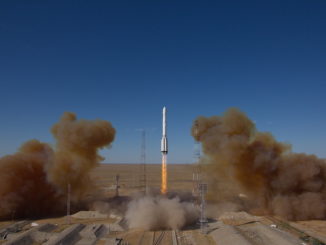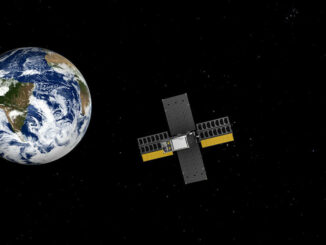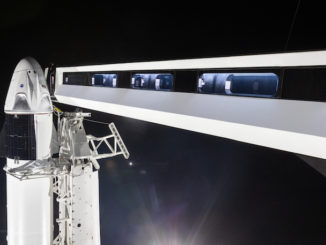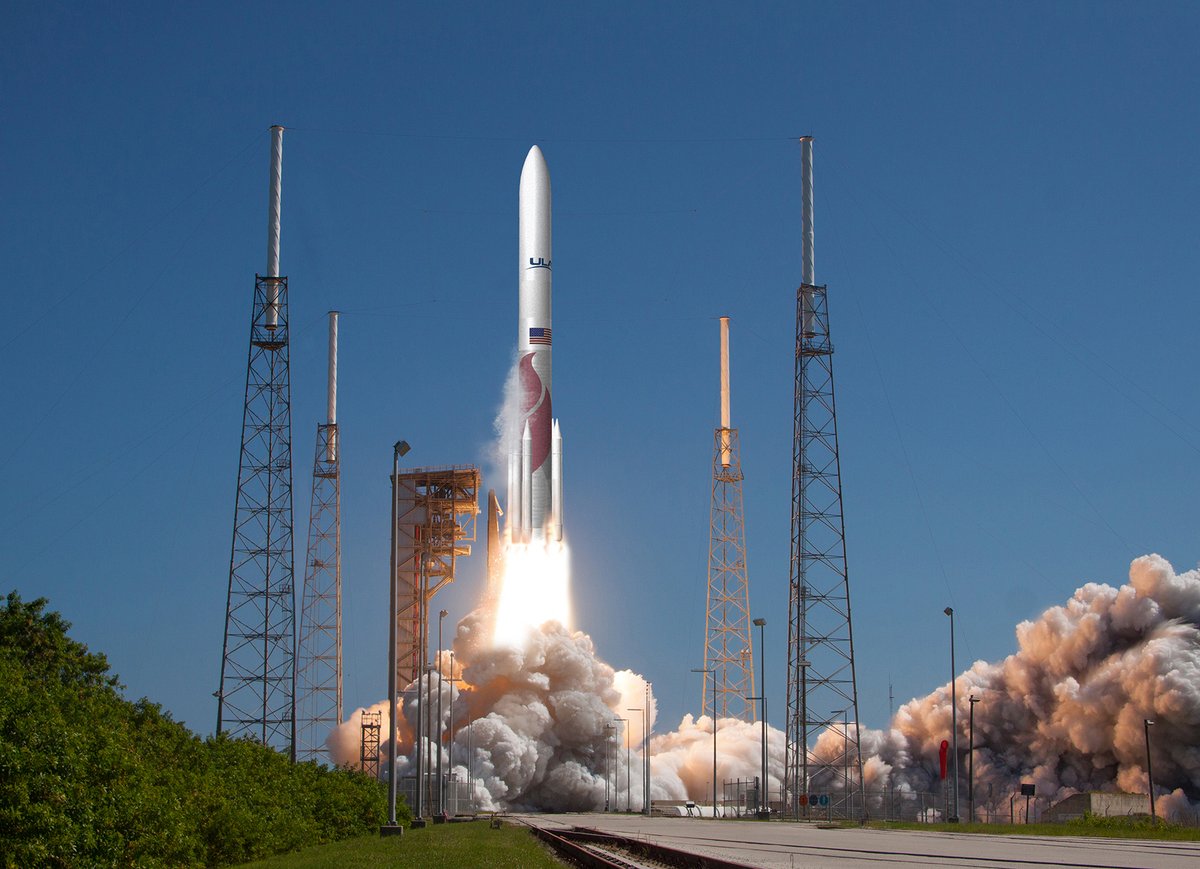
United Launch Alliance and SpaceX beat out Northrop Grumman and Jeff Bezos’ Blue Origin for billions of dollars in U.S. military rocket contracts, and will share the load in launching the Pentagon’s highest-priority national security space missions through 2027, officials announced Friday.
ULA, the 50-50 joint venture formed in 2006 by Boeing and Lockheed Martin, will get 60 percent of the military’s most critical satellite launch contracts awarded through late 2024 for missions that will take off between 2022 and late 2027. SpaceX will receive 40 percent of the national security launch contracts over the same period, the Pentagon said.
The Pentagon did not select proposals submitted by Northrop Grumman and Blue Origin.
The agreements cover contracts to launch satellites for the U.S. Space Force, the National Reconnaissance Office, the Missile Defense Agency, and other military services and agencies, providing an anchor customer for SpaceX and ULA.
“This is a groundbreaking day, culminating years of strategic planning and effort by the Department of the Air Force, NRO, and our launch service industry partners,” said Will Roper, assistant secretary of the U.S. Air Force for acquisition, technology and logistics. “Maintaining a competitive launch market, servicing both government and commercial customers, is how we encourage continued innovation on assured access to space.”
The agreements with ULA and SpaceX are part of Phase 2 of the Pentagon’s effort to transition military satellite launches off of rockets using Russian-made RD-180 engines, and onto vehicles with U.S.-built engines. ULA’s Atlas 5 rocket has launched more national security satellites than any other rocket currently in service, and its first stage is powered by the RD-180 engine.
The procurement strategy is also intended to reduce launch costs for the Pentagon.
“We have been stuck on Russian RD-180 engines for too long,” Roper said Friday in a conference call with reporters. It is a risk to our national security, so many years ago the Air Force decided to create an acquisition strategy to get us through the sole-source environment that we were in with a single rocket provider, and still tied to Russian engines, (and) build up a competitive U.S. industry base that would ultimately culminate in today, in a Phase 2 award to two vendors.”
The announcement Friday also marked the end of a hard-fought competition between four major players in the U.S. space industry for a chance at billions of dollars in revenue from lucrative military launch contracts.
ULA is developing the next-generation Vulcan Centaur rocket, with all U.S.-made engines, to replace its Atlas and Delta launch vehicles, and SpaceX offered the Pentagon its Falcon 9 and Falcon Heavy rockets already in service, albeit with some modifications to meet the military’s demanding launch requirements.
“ULA is honored to be selected as one of two launch providers in this procurement,” said Tory Bruno, ULA’s president and CEO. “Vulcan Centaur is the right choice for critical national security space missions and was purpose built to meet all of the requirements of our nation’s space launch needs.
“For decades, we have been a trusted partner to safely and securely deliver strategic national security space assets for our nation’s defense and this award shows the continued confidence of our customer in the commitment and dedication of our people to safeguard these missions by reliably launching our country’s most critical and challenging missions,” Bruno said in a statement.
SpaceX did not respond to a request for comment Friday on the Pentagon launch contract award.
Northrop Grumman’s OmegA rocket and Blue Origin’s New Glenn launch vehicle were also in the running.
Despite losing out on the Phase 2 awards with their own rockets, Northrop Grumman and Blue Origin will still get business through national security launches. Northrop Grumman will supply solid rocket boosters and Blue Origin will build BE-4 main engines for ULA’s Vulcan Centaur rocket.
“We evaluated every proposal by the published award criteria, technical factors being first and foremost, then followed by past performance, their ability to work with small business, and then finally totally evaluated price,” Roper said. “Every proposal is evaluated. We call the ball and strikes as they are, and the ability to meet those technical factors — to do the mission –is the most important thing above all.”
For nearly a decade, the Pentagon awarded sole-source national security launch contracts to ULA, which builds and operates the fleet of Atlas and Delta rockets that have delivered to orbit nearly all of the military’s large reconnaissance, surveillance, communications, navigation and missile warning satellites currently in use.
But rising launch costs, pressure from upstart SpaceX, and worsening diplomatic relations with Russia prompted the Air Force to rethink its rocket procurement strategy for the military’s highest-priority space missions. Congress also passed a law in 2014 — after Russia’s annexation of Crimea — that capped the number of RD-180 engines the military could use to launch national security satellites before transitioning to a rocket with U.S.-made propulsion.
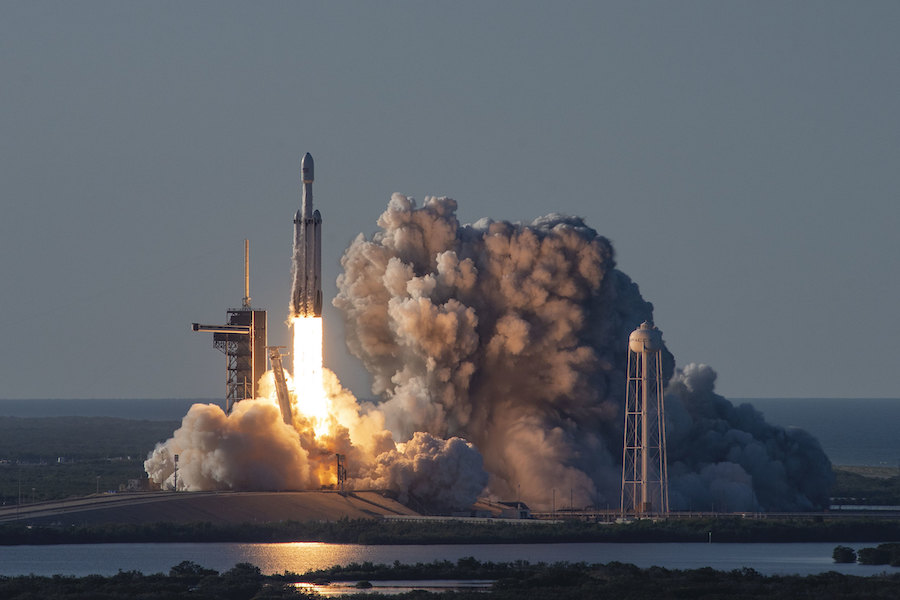
The highest-priority class of payloads was previously part of the Evolved Expendable Launch Vehicle, or EELV, program. Last year, military officials renamed the EELV program as the National Security Space Launch, or NSSL, program as the Pentagon moved into a new era of launch services, which include reusable rockets.
The Air Force ended competition for its EELV-class missions when the Pentagon approved the Boeing and Lockheed Martin consolidation in 2006, a decision ULA and military officials said was necessary to ensure the survival of the Atlas and Delta rocket families to launch U.S. national security satellites.
Pentagon officials say the military needs two independent launchers to ensure crucial payloads can get to space even if one of the rockets is grounded.
The Air Force certified SpaceX’s Falcon 9 rocket to launch national security satellites in 2015, a process the military promised to speed up after SpaceX filed a lawsuit against the Air Force the previous year protesting the Pentagon’s $11 billion “block buy” sole-source order of Atlas 5 and Delta 4 rockets in 2013.
Military officials made more launch contracts available for competition between ULA and SpaceX in an intermediate “Phase 1A” procurement round before moving on to Phase 2, which required rockets use only U.S.-made engines.
The Air Force awarded funding to Aerojet Rocketdyne, Northrop Grumman, SpaceX and United Launch Alliance in 2016 as part of cost-sharing public-private partnerships with industry to advance research and development of new U.S. rocket propulsion systems.
In 2018, the Air Force selected Blue Origin, Northrop Grumman and United Launch Alliance for the next round of launch service agreement awards. Those agreements were cumulatively valued at around $2.3 billion.
SpaceX, which was the only company competing with a rocket already flying, was left out of the development contracts awarded in 2018.
The Pentagon also announced Friday the first three firm-fixed-price launch contracts awarded by the U.S. Space Force under the NSSL program’s Phase 2 agreements.
Two of those missions, designated USSF-51 and USSF-106, were awarded to ULA for launches in the the first quarter and third quarter of calendar year 2022. SpaceX won a task order to launch the USSF-67 mission in the third quarter of calendar year 2022.
ULA received $337 million in the task orders announced Friday, while SpaceX was awarded $316 million.
If ULA’s Vulcan Centaur rocket, which scheduled to debut in 2021, is not certified for the national security missions in 2022, ULA could offer an Atlas 5 rocket — with its Russian-made engine — as an alternative for the USSF-51 and USSF-106 missions.
A contract announcement posted on a Defense Department website said the contracts include “early integration studies, launch service support, fleet surveillance, launch vehicle production, mission integration, mission launch operations, mission assurance, spaceflight worthiness, and mission unique activities for each mission.”
Roper said of the 18 RD-180 engines Congress has allowed the Pentagon to buy through 2022 for national security missions, 12 remain available for purchase. There’s no prohibition on when the engines can actually launch a national security mission, just that the Pentagon can’t procure any more launches using the RD-180 engines after 2022.
“By the end of ’22, we cannot buy any more RD-180 engines,” Roper said. “We do have 12 engines that are available should we need to use those engines beyond the ’22 mark. We’re allowed to use them. We’re just allowed to purchase more. So the reason that this Phase 2 award weighted technical performance — technical merit — as the No. 1 priority is that we have to ensure that we get off of those engines.
“I’m very confident with the selection that we have made today that we have a very low risk path to get off the RD-180 engines on time and to not have to dip into that surplus that we have available, though we’re glad to know it’s there should we need it.”
The three task orders unveiled Friday are just the tip of the iceberg for ULA and SpaceX, which stand to compete head-to-head for dozens more national security launches contracts over the next four years. The U.S. Space Force’s Space and Missile Systems Center, or SMC, will order launch services annually from ULA and SpaceX, the military said in a statement.
Roper said military officials estimated SMC would order 32 to 34 national security launches during the five-year period covered by the Phase 2 agreements. But there is some uncertainty in that number, Roper said.
“It is an indefinite quantity contract because we wanted to be ready for a number of launches that can be in flux,” Roper said Friday.
That will help ensure ULA and SpaceX can relay on a steady “drum beat” of launches for the Pentagon, supplementing commercial missions on their launch manifests, he said.
“So there’s no ceiling on this contract,” Roper said. “It’s driven by the number of launches that we and the NRO, and organizations like the Missile Defense Agency and the Space Development Agency need.
“We’re very excited within the Space Force to provide a launch capability to the entire department that its dependable and reliable, and we look forward to building on the 81-out-81 mission success that the Air Force, and now the Space Force, has provided over the past years,” Roper said.

While SpaceX’s Falcon 9 and Falcon Heavy rockets have the lift capacity to meet the Pentagon’s launch requirements, which include access to unusual, hard-to-reach orbits, there will be some changes on the launch vehicles and ground systems to accommodate the new missions.
For the Pentagon’s Phase 2 missions, SpaceX did not propose using the company’s next-generation Starship launch vehicle.
“It’s Falcon 9 and Falcon Heavy, no Starship,” said Gwynne Shotwell, SpaceX’s president and chief operating officer, last year. “We bid to meet every requirement. The only modifications we need are an extended fairing on the Falcon Heavy, and we are going to have to build a vertical integration capability. But we are basically flying the rockets that they need.
“There are more data requirements they’re asking for, some additional inspection, some additional stuff that’s new to Phase 2,” she said. “I believe some of the reference orbits have slightly more mass to each orbit. But Falcon 9 and Falcon Heavy are beasts as they are.”
The most significant upgrades SpaceX plans for the Phase 2 missions are the construction of a new moveable gantry on pad 39A at NASA’s Kennedy Space Center, where the company launches powerful Falcon Heavy rockets. The mobile tower will sit just to the north of the pad’s launch mount, enabling SpaceX to satisfy military requirements to vertically integrate sensitive top secret spy satellites.
Read our earlier story for details on the dimensions and requirement for the gantry.
SpaceX will also introduce a larger payload envelope to fit some of the biggest satellites that need to be launched on the Phase 2 missions. The company could expand its Falcon 9 launch pad at Vandenberg Air Force Base in California to accommodate the Falcon Heavy, which uses three Falcon 9 first stage boosters bolted together.
The NSSL missions include the military’s most expensive and critical payloads, such as school bus-sized spy satellites, nuclear-hardened communications satellites to link the president with military commanders, spacecraft to detect enemy missile launches, and the GPS navigation fleet used around the world.
The Space Force has other launch procurement mechanisms to award launch service contracts for smaller missions, such as technology demonstration satellites.
Roper said the Pentagon will work with Blue Origin and Northrop Grumman to wind down their work under the launch service agreements awarded in 2018.
“The goal is not to carry them indefinitely,” Roper said. “So we will tie off the (launch service agreement) contracts as soon as we can at a point that makes sense. We want to make sure that work that’s in flux, that we’re able to document that … Where the government has rights to the data and the work, we want to make sure that we retain those.”
In a statement, Northrop Grumman said it was disappointed in the Pentagon’s decision to go with ULA and SpaceX for the Phase 2 awards.
“We are confident we submitted a strong proposal that reflected out extensive space launch experience and provided value to our customer, and we are looking forward to our debriefing from the customer,” Northrop Grumman said.
The fate of Northrop Grumman’s OmegA rocket program is uncertain. Building on its recent acquisition of Orbital ATK, the defense contractor designed the OmegA launch vehicle to be profitable with just a handful of launches per year, with an emphasis on capabilities aimed at the U.S. military’s requirements.
In recent months, construction crews have been assembling a tower on a mobile launch platform for the OmegA rocket at the Kennedy Space Center in Florida. Charlie Precourt, vice president of propulsion systems at Northrop Grumman, said in an interview in June that qualification test-firings of the OmegA rocket’s solid-fueled stages were completed, and engineers were gearing up for a test-firing of the launcher’s hydrogen-fueled upper stage before the end of this year.
Precourt said in June that the OmegA rocket was on schedule to be ready for its first test launch from pad 39B at the Kennedy Space Center in mid-2021. But that assumed Northrop Grumman would win a Phase 2 award from the Pentagon.
Blue Origin says development of its New Glenn rocket will continue in pursuit of business in the commercial and civil space markets.
The huge privately-developed rocket is the largest of all the launchers that were part of the Phase 2 competition. Capable of deploying up to 99,000 pounds, or 45 metric tons, to low Earth orbit, the New Glenn will have a reusable first stage powered by seven BE-4 engines.
ULA’s Vulcan Centaur rocket will have two methane-fueled BE-4 engines on its first stage.
Jeff Bezos, the billionaire founder of Amazon.com, established Blue Origin in 2000. Bezos is funding the development of the New Glenn rocket, which is estimated to cost more than $2.5 billion, including construction of a huge factory near the Kennedy Space Center and a launch pad and test facility at Cape Canaveral Air Force Station.
Bob Smith, Blue Origin’s CEO, said the company was disappointed the New Glenn was not selected for a Phase 2 launch service procurement contract.
“We submitted an incredibly compelling offer for the national security community and the U.S. taxpayer,” Smith said. “Blue Origin’s offer was based on New Glenn’s heavy-lift performance, unprecedented private investment of more than $2.5 billion, and a very competitive single basic launch service price for any mission across the entire ordering period.
“We are proceeding with New Glenn development to fulfill our current commercial contracts, pursue a large and growing commercial market, and enter into new civil space launch contracts,” Smith said. “We remain confident New Glenn will play a critical role for the national security community in the future due to the increasing realization that space is a contested domain and a robust, responsive, and resilient launch capability is ever more vital to U.S security.”
The Pentagon plans to open another competition for a Phase 2 launch service procurement later in the 2020s.
“We don’t think that this is the last round of innovation that we’re going see, and though we’re excited for the next five years of Phase 2, we’re looking ahead to Phase 3 five years from now, and are just wondering what new leap-ahead, lower-cost technologies might be on the forefront to make assured access to space not just assured, but cheaper,” Roper said.
Email the author.
Follow Stephen Clark on Twitter: @StephenClark1.

